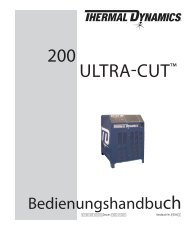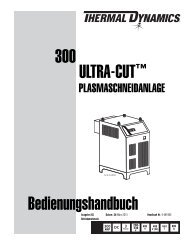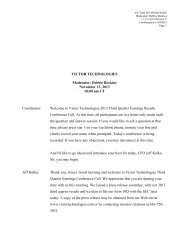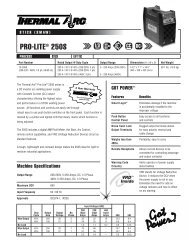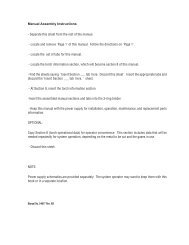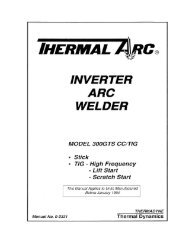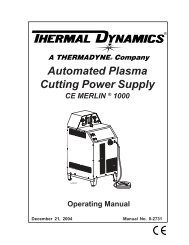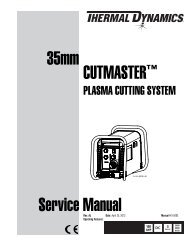appendix 1 - Victor Technologies
appendix 1 - Victor Technologies
appendix 1 - Victor Technologies
Create successful ePaper yourself
Turn your PDF publications into a flip-book with our unique Google optimized e-Paper software.
cut being more square than the other. Viewed along the<br />
direction of travel, the right side of the cut is more square<br />
than the left.<br />
E. Dross<br />
When dross is present on carbon steel, it is commonly<br />
referred to as either “high speed, slow speed, or top<br />
dross”. Dross present on top of the plate is normally<br />
caused by too great a torch to plate distance. "Top<br />
dross" is normally very easy to remove and can often<br />
be wiped off with a welding glove. "Slow speed<br />
dross" is normally present on the bottom edge of the<br />
plate. It can vary from a light to heavy bead, but<br />
does not adhere tightly to the cut edge, and can be<br />
easily scraped off. "High speed dross" usually forms<br />
a narrow bead along the bottom of the cut edge and<br />
is very difficult to remove. When cutting a troublesome<br />
steel, it is sometimes useful to reduce the cutting<br />
speed to produce "slow speed dross". Any resultant<br />
cleanup can be accomplished by scraping, not<br />
grinding.<br />
F. Common Cutting Faults<br />
1. Insufficient Penetration<br />
a. Cutting speed too fast<br />
b. Torch tilted too much<br />
c. Metal too thick<br />
d. Worn torch parts<br />
e. Cutting current too low<br />
f. Drag cutting above 35 amps ("Tip Saver Circuit")<br />
2. Main Arc Extinguishes<br />
a. Cutting speed too slow<br />
b. Torch standoff too high from workpiece<br />
c. Cutting current too high<br />
d. Work cable disconnected or bad connection<br />
e. Worn torch parts<br />
3. Excessive Dross Formation<br />
a. Cutting speed too slow<br />
b. Torch standoff too high from workpiece<br />
c. Worn torch parts<br />
d. Improper cutting current<br />
e. Improper gas selection for cutting material<br />
4. Short Torch Parts Life<br />
a. Oil or moisture in air source<br />
b. Exceeding system capability (material too thick)<br />
c. Excessive pilot arc time<br />
d. Air flow too low (incorrect pressure)<br />
e. Improperly assembled torch<br />
f. Incorrect torch parts for the operation<br />
g. Non-Genuine Thermal Dynamics parts used<br />
4.05 Troubleshooting Guide -<br />
General Information<br />
WARNING<br />
There are extremely dangerous voltage and power<br />
levels present inside this unit. Do not attempt to<br />
diagnose or repair unless you have had training in<br />
power electronics measurement and troubleshooting<br />
techniques.<br />
A. Basic Troubleshooting<br />
For basic troubleshooting and parts replacement, refer to<br />
Operating Manual. This manual should be your first resource<br />
for troubleshooting. If the problem cannot be remedied<br />
using the Operating Manual, refer to the advanced<br />
troubleshooting in this Service Manual.<br />
B. Advanced Troubleshooting<br />
This manual provides advanced troubleshooting and<br />
parts replacement not covered in the basic troubleshooting<br />
section of the Operating Manual. In most cases, it<br />
requires Power Supply disassembly and live measurements.<br />
Troubleshooting and repair of this unit is a process which<br />
should be undertaken only by those familiar with high<br />
voltage high power electronic equipment.<br />
If major complex subassemblies are faulty, the faulty subassembly<br />
must be returned for repair.<br />
NOTE<br />
Follow all instructions as listed and complete each<br />
in the order presented.<br />
Manual 0-2697 4-5 SERVICE



